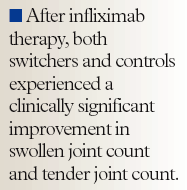- Safety & Recalls
- Regulatory Updates
- Drug Coverage
- COPD
- Cardiovascular
- Obstetrics-Gynecology & Women's Health
- Ophthalmology
- Clinical Pharmacology
- Pediatrics
- Urology
- Pharmacy
- Idiopathic Pulmonary Fibrosis
- Diabetes and Endocrinology
- Allergy, Immunology, and ENT
- Musculoskeletal/Rheumatology
- Respiratory
- Psychiatry and Behavioral Health
- Dermatology
- Oncology
Prior lack of efficacy with etanercept does not predict lack of efficacy with infliximab
A study conducted by researchers at the University of Wisconsin, Stanford University, and several rheumatology clinics across the United States found that rheumatoid arthritis (RA) patients who do not receive sufficient benefit with etanercept may experience improved disease control by switching to infliximab.
A study conducted by researchers at the University of Wisconsin, Stanford University, and several rheumatology clinics across the United States found that rheumatoid arthritis (RA) patients who do not receive sufficient benefit with etanercept may experience improved disease control by switching to infliximab.
The multicenter (6 sites) retrospective study of 93 patients with RA taking leflunomide was conducted to determine the clinical benefit in patients with prior use of etanercept (n=20, "switchers") as compared to the efficacy of infliximab in patients receiving no prior tumor necrosis factor (TNF) inhibitors (n=73, "controls"). The mean number of prior disease-modifying anti-rheumatic drugs (DMARDs) (aside from infliximab and leflunomide) was significantly higher in switchers compared to controls (4.3 and 2.5, respectively; P=.0001). Of the 20 patients who discontinued etanercept therapy, 17 attributed the discontinuation to lack of efficacy.
At the end of the study, the controls had received an average of 5 infliximab infusions with a mean dose of 3.19 mg/kg, and the switchers had received an average of 5.7 infliximab infusions with a mean dose of 4.4 mg/kg (P=.006 for the difference in mg/kg dose). Researchers compared efficacy measures at the time point prior to initiating infliximab therapy and after initiation of infliximab therapy using the Wilcoxon rank sum test and Fischer's exact test.

Study authors addressed several weaknesses of the study, including the fact that there was a higher use of concomitant DMARDs in switchers (20%, including azathioprine, n=1; sulfasalazine n=1; methonitrate, n=2) than in controls (5.4%, including methotrexate; n=3, hydroxychloroquine; n=1), which could have predisposed the switchers to present better. In addition, the authors stated: "The study also provides only short-term data on the response to infliximab, and does not assess whether patients experiencing previous anti-TNF treatment failure will manifest a less robust long-term response to the drug, or require higher doses to achieve full benefits."
The study authors call for further research to "better define the patient characteristics that predict a response to different TNF inhibitors, such as pharmacokinetics, TNF polymorphisms, cytokine profiles, and disease parameters."
SOURCE Hansen KE, Hildebrand JP, Genovese MC, et al. The efficacy of switching from etanercept to infliximab in patients with rheumatoid arthritis. J Rheumatol. 2004;31:1098-1102.
